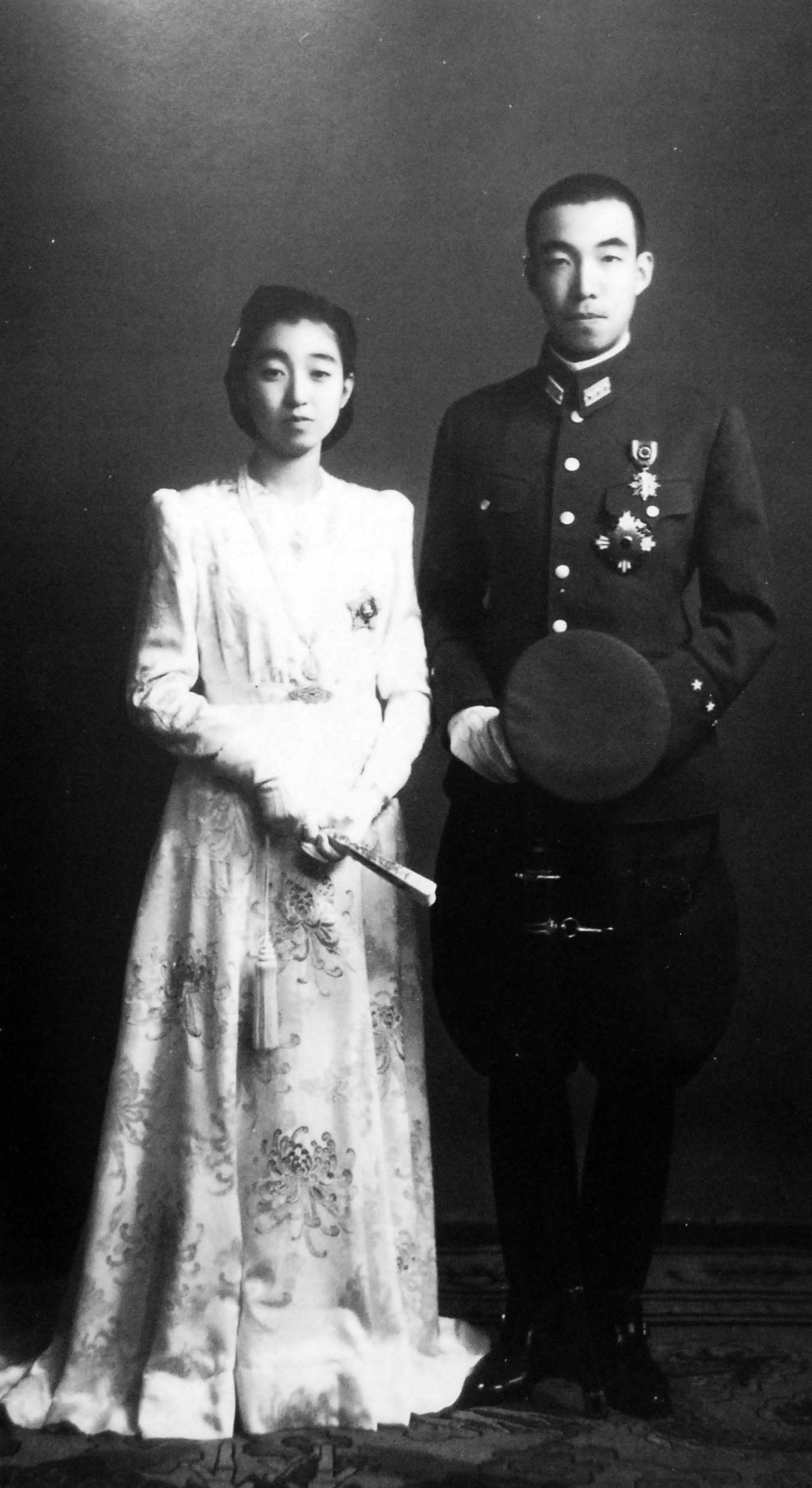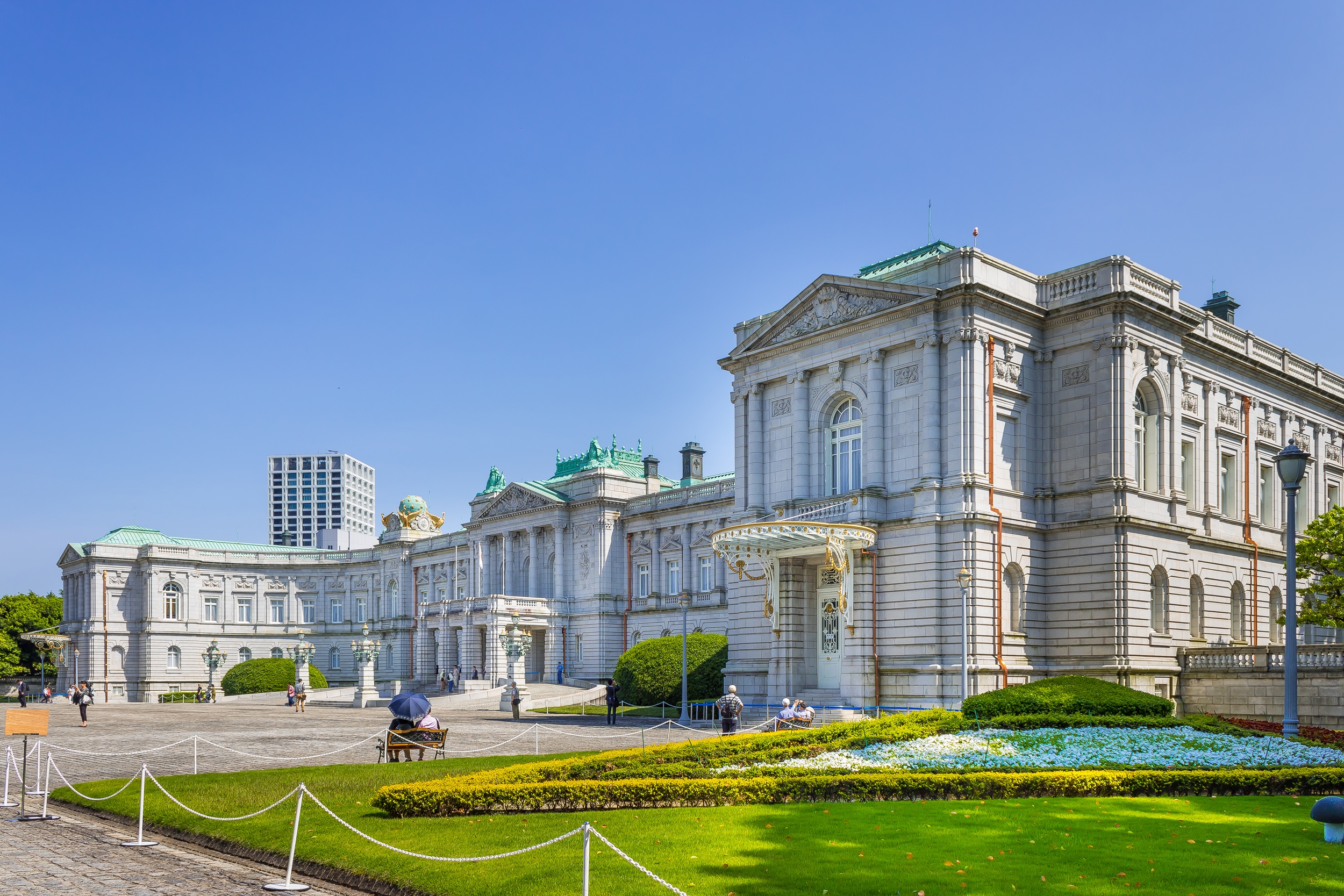|
Shigeko Higashikuni
, born , was the wife of Prince Morihiro Higashikuni and eldest daughter of Emperor Shōwa and Empress Kōjun. She was the eldest sister to Japan's Emperor Emeritus Akihito. Biography Princess Shigeko was born at Akasaka Palace in Tokyo while her father was still Prince Regent for her grandfather the Taishō Emperor. Her childhood appellation was ("Princess Teru"). As was the practice of the time, she was not raised by her biological parents after the age of three, but by a succession of court ladies at a separate palace built for her and her younger sisters in the Marunouchi district of Tokyo from 1930. Emperor Shōwa opposed the move, but could not defy court tradition. She entered the girls elementary department of the Gakushūin Peer's School in 1932 and completed the secondary department in 1942, learning cooking and literature. On 9 May 1939, Princess Shigeko rode on the Chōshi Electric Railway Line in Chiba Prefecture from to Tōdaimae and back as part of a Gakushūi ... [...More Info...] [...Related Items...] OR: [Wikipedia] [Google] [Baidu] |
Akasaka Palace
, or the , is one of the two state guest houses of the Government of Japan. The other state guesthouse is the Kyoto State Guest House. The palace was originally built as the in 1909. Today the palace is designated by the Government of Japan as an official accommodation for visiting state dignitaries. Located in the Moto-Akasaka, Minato, Tokyo, the building took on its present function in 1974, having previously been an imperial detached palace. In 2009 the palace was designated as a National Treasure of Japan. Overview Location: Tokyo, Minato-ku, Moto-Akasaka-chome No. 1 The building has 15,000 m2 of floor space, and together with a smaller structure in the Japanese style, occupies a 117,000 m2 site. The main building is a Neo-Baroque style Western building, resembling in particular the Hofburg Palace. It is one of largest buildings constructed during the Meiji period. The palace is surrounded by a footpath unobstructed by road crossings. The footpath is approximately ... [...More Info...] [...Related Items...] OR: [Wikipedia] [Google] [Baidu] |
Prince Naruhiko Higashikuni
General was a Japanese imperial prince, a career officer in the Imperial Japanese Army and the 30th Prime Minister of Japan from 17 August 1945 to 9 October 1945, a period of 54 days. An uncle-in-law of Emperor Hirohito twice over, Prince Higashikuni was the only member of the Japanese imperial family to head a cabinet and was the last general officer of the Imperial Japanese military to become Prime Minister. He was the founder of the Chiba Institute of Technology. He was one of the longest-lived members of any royal family. Early life Prince Naruhiko was born in Kyoto, the ninth son of Prince Kuni Asahiko (''Kuni no miya Asahiko Shinnō'') and the court lady Terao Utako. His father, Prince Asahiko, was a son of Prince Fushimi Kuniie (''Fushimi no miya Kuniie Shinnō''), the twentieth head of the Fushimi-no-miya, the oldest of the '' sesshu shinnōke'' or cadet branches of the imperial dynasty from whom an emperor might be chosen in default of a direct heir. Prince Naruhiko ... [...More Info...] [...Related Items...] OR: [Wikipedia] [Google] [Baidu] |
Imperial Household Agency
The (IHA) is an agency of the government of Japan in charge of state matters concerning the Imperial Family, and also the keeping of the Privy Seal and State Seal of Japan. From around the 8th century AD, up until the Second World War, it was known as the . The Agency is unique among conventional government agencies and ministries, in that it does not directly report to the Prime Minister at the cabinet level, nor is it affected by legislation that establishes it as an Independent Administrative Institution. Organization and functions The IHA is headed by the Director-General of IHA, assisted by the Deputy Director of IHA, appointed by the Cabinet.Imperial Household AgencyOrganization/ref> The main organizational positions within the Agency are: * the Grand Steward's Secretariat * the Board of Chamberlains * the Crown Prince's Household * the Board of Ceremonies * the Archives and Mausolea Department * the Maintenance and Works Department * the Kyoto Office The current ... [...More Info...] [...Related Items...] OR: [Wikipedia] [Google] [Baidu] |
Cancer
Cancer is a group of diseases involving abnormal cell growth with the potential to invade or spread to other parts of the body. These contrast with benign tumors, which do not spread. Possible signs and symptoms include a lump, abnormal bleeding, prolonged cough, unexplained weight loss, and a change in bowel movements. While these symptoms may indicate cancer, they can also have other causes. Over 100 types of cancers affect humans. Tobacco use is the cause of about 22% of cancer deaths. Another 10% are due to obesity, poor diet, lack of physical activity or excessive drinking of alcohol. Other factors include certain infections, exposure to ionizing radiation, and environmental pollutants. In the developing world, 15% of cancers are due to infections such as ''Helicobacter pylori'', hepatitis B, hepatitis C, human papillomavirus infection, Epstein–Barr virus and human immunodeficiency virus (HIV). These factors act, at least partly, by changing the genes of ... [...More Info...] [...Related Items...] OR: [Wikipedia] [Google] [Baidu] |
Uta-garuta
is a type of a deck of ''karuta'', Japanese traditional playing cards. A set of ''uta-garuta'' contains 100 cards, with a ''waka'' poem written on each. ''Uta-garuta'' is also the name of the game in which the deck is used. The standard collection of poems used is the ''Hyakunin Isshu'', chosen by poet Fujiwara no Teika in the Heian period, which is often also used as the name of the game. Since early 20th century the game is played mostly on Japanese New Year holidays. How to play Basic rules The game uses two types of cards. *''Yomifuda'' (lit. "Reading Cards"): One hundred cards with a figure of a person, their name, and a complete poem by them on each. *''Torifuda'' (lit. "Grabbing Cards"): One hundred cards with only the finishing phrases of the poems on each. The game is played with the players seated on the floor. At the start of a game, 100 ''torifuda'' are neatly arranged on the floor face up between the players. When the reader starts reading out a poem on the ''yom ... [...More Info...] [...Related Items...] OR: [Wikipedia] [Google] [Baidu] |
Television Network
A television network or television broadcaster is a telecommunications network for distribution of television program content, where a central operation provides programming to many television stations or multichannel video programming distributor, pay television providers. Until the mid-1980s, television broadcast programming, programming in most countries of the world was dominated by a small number of terrestrial networks. Many early television networks (such as NBC, the Australian Broadcasting Corporation, ABC, or the BBC) evolved from earlier radio networks. Overview In countries where most networks broadcast identical, centrally originated content to all of their stations and where most individual television transmitters therefore operate only as large "broadcast relay station, repeater stations", the terms "television network", "television channel" (a numeric identifier or radio frequency) and "television station" have become mostly interchangeable in everyday language, wit ... [...More Info...] [...Related Items...] OR: [Wikipedia] [Google] [Baidu] |
Inflation
In economics, inflation is an increase in the general price level of goods and services in an economy. When the general price level rises, each unit of currency buys fewer goods and services; consequently, inflation corresponds to a reduction in the purchasing power of money. The opposite of inflation is deflation, a sustained decrease in the general price level of goods and services. The common measure of inflation is the inflation rate, the annualized percentage change in a general price index. As prices do not all increase at the same rate, the consumer price index (CPI) is often used for this purpose. The employment cost index is also used for wages in the United States. Most economists agree that high levels of inflation as well as hyperinflation—which have severely disruptive effects on the real economy—are caused by persistent excessive growth in the money supply. Views on low to moderate rates of inflation are more varied. Low or moderate inflation may be attri ... [...More Info...] [...Related Items...] OR: [Wikipedia] [Google] [Baidu] |
Supreme Commander Of The Allied Powers
was the title held by General Douglas MacArthur during the United States-led Allied occupation of Japan following World War II. It issued SCAP Directives (alias SCAPIN, SCAP Index Number) to the Japanese government, aiming to suppress its "militaristic nationalism". The position was created at the start of the occupation of Japan on August 14, 1945. In Japan, the position was generally referred to as GHQ (General Headquarters), as SCAP also referred to the offices of the occupation (which was officially referred by SCAP itself as ), including a staff of several hundred US civil servants as well as military personnel. Some of these personnel effectively wrote a first draft of the Japanese Constitution, which the National Diet then ratified after a few amendments. Australian, British Empire, and New Zealand forces under SCAP were organized into a sub-command known as British Commonwealth Occupation Force. These actions led MacArthur to be viewed as the new Imperial force in Japan ... [...More Info...] [...Related Items...] OR: [Wikipedia] [Google] [Baidu] |
Kimono
The is a traditional Japanese garment and the national dress of Japan. The kimono is a wrapped-front garment with square sleeves and a rectangular body, and is worn left side wrapped over right, unless the wearer is deceased. The kimono is traditionally worn with a broad sash, called an , and is commonly worn with accessories such as zōri sandals and socks. Kimono have a set method of construction and are typically made from a long, narrow bolt of cloth known as a , though Western-style fabric bolts are also sometimes used. There are different types of kimono for men, women, and children, varying based on the occasion, the season, the wearer's age, and – less commonly in the modern day – the wearer's marital status. Despite the kimono's reputation as a formal and difficult-to-wear garment, there are types of kimono suitable for both formal and informal occasions. The way a person wears their kimono is known as . Though previously been the most common Japanese garm ... [...More Info...] [...Related Items...] OR: [Wikipedia] [Google] [Baidu] |
World War II
World War II or the Second World War, often abbreviated as WWII or WW2, was a world war that lasted from 1939 to 1945. It involved the vast majority of the world's countries—including all of the great powers—forming two opposing military alliances: the Allies and the Axis powers. World War II was a total war that directly involved more than 100 million personnel from more than 30 countries. The major participants in the war threw their entire economic, industrial, and scientific capabilities behind the war effort, blurring the distinction between civilian and military resources. Aircraft played a major role in the conflict, enabling the strategic bombing of population centres and deploying the only two nuclear weapons ever used in war. World War II was by far the deadliest conflict in human history; it resulted in 70 to 85 million fatalities, mostly among civilians. Tens of millions died due to genocides (including the Holocaust), starvation, ma ... [...More Info...] [...Related Items...] OR: [Wikipedia] [Google] [Baidu] |





